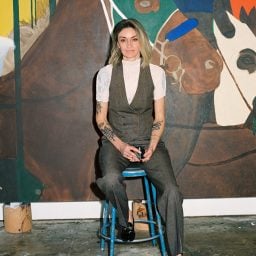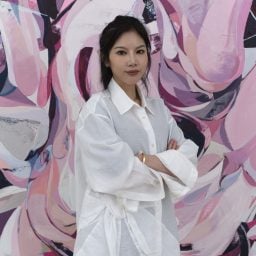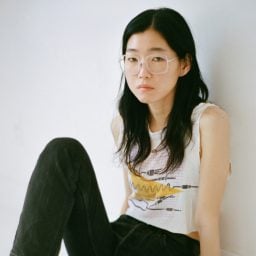Once upon a time, maybe in a not-so-distant future, a long-abandoned home found itself slowly swallowed in a camouflage of vegetation. Acid yellow shoots with bright orange markings crept over the home’s fireplace, mantel, and floorboards. Even the paintings lining the walls were subsumed, bearing now only these vegetal striations, their original subject matter obscured.
These enveloping tendrils and vines, one soon realized with surprise or alarm, all led back to a few humble houseplants, who had invaded all elements of the human architecture around them. Suddenly, and much to our shock, an uncanny impersonation of Arnold Schwarzenegger’s Terminator could be heard throughout the home, saying “I’ll be back”.
This satirical meets science fiction premise was the underpinning narrative of artist Phaan Howng’s debut solo exhibition “I’ll Be Back” with New York’s Dinner Gallery in the spring of last year. And the exhibition did reach nearly cinematic production levels. Through painstakingly detailed installations of hand-painted wallpaper, sculpture, and painting, Howng (b. 1982) managed to transform the ground floor gallery into an imagined near-future artifact of a Victorian parlor—a relic in a world now absent of human life and reclaimed by the houseplants people once believed they owned. Howng calls these works “optimistic post-apocalypse” and the titles “make her laugh,” allowing her to deal with such “totally depressing” subject matter.

Installation view “Phaan Howng: I’ll Be Back” at Dinner Gallery, New York, 2022.
Over the past few years, the Baltimore-based artist has been garnering growing attention for such camouflaged vegetal installations and paintings, which investigate global capitalism, environmental crisis, and the liberal arts through a lens of Victorian micro-histories and blockbuster action movies. In 2017 and ’18, she debuted The Succession of Nature, an immersive art installation at the Baltimore Museum of Art, which underscored local struggles with toxic waters through glaringly intense color tones.
Now Howng is back in the studio working on a new series of canvases slated for a solo presentation at the Armory Show with Dinner Gallery this fall that will riff on the conspiracy minded TV show “Ancient Aliens,” she says. Recently, we spoke with this on-the-rise artist and delved into the myriad influences at play in her sought-after works.
Lawn & Order
Growing up in New Mexico and then South Florida, Howng has vivid memories of her father working to maintain the idyllic lush green American lawn—a nearly impossible task in environments naturally ill-suited to such perfect turf. These memories formed the basis of some of her earliest works; as an undergraduate at Boston University, she built a portfolio centered on photorealistic oil paintings of her father meticulously at work trimming hedges and mowing the lawn.
“South Florida has a lot to do with my work. There are palm trees everywhere, but only one species of palm is native to South Florida,” she explained, “The rest have been imported. You realize you’re living in this made-up image that Florida wanted to create for tourists.” Such early fascinations morphed in later years into an exploration of gardens as places of control and how cultivated gardens intersect with labor and the environment. “There are the type with fake rocks as speakers and AstroTurf who don’t want to mow the lawn vs someone who goes to town, planting whatever they want,” she notes, “but it’s all related.”
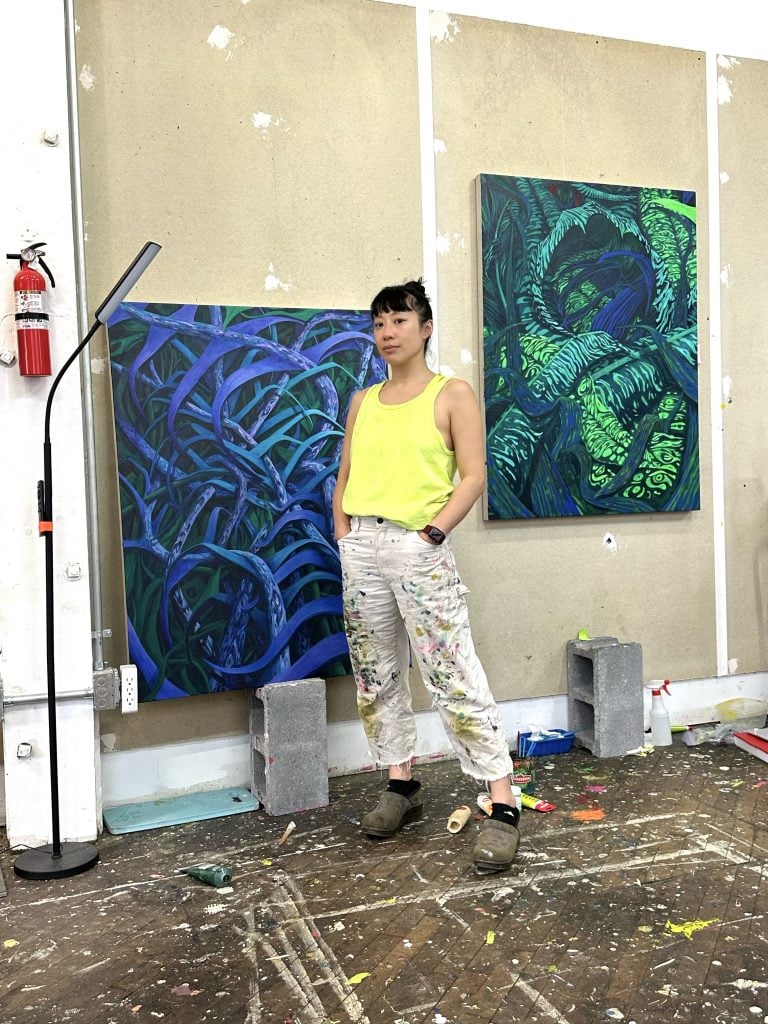
Courtesy of Phaan Howng.
In one series of works, Howng explored how Chinese and Japanese gardens have tried to simulate art. “I had a show about gardens that have been based on Chinese landscape paintings—so two-dimensional abstract watercolor paintings that people wanted to turn into their private installation,” she said. “I worked in supply chain at one point in my life and I kept thinking about how people got these objects to get from Point A to Point B. Sometimes a rock was excavated in Southern China, from one lake and then hauled up to Beijing. I wonder what labor was exploited there.”
Then in 2020, during the height of quarantine, when Howng, scrolling through her phone, noticed a peculiar trend—a rising number of houseplant influencers on social media—which sparked off the most recent metamorphosis of her works. “I began to really wonder why we can’t grasp climate change or take meaningful action, but we’re interested in controlling nature in our homes. We objectify plants in a way that I find strange and I began to wonder how houseplants even came about,” she said.
She has no talent as a green thumb, but had managed to keep some snake plants alive. “That inspired my ‘Snakes on a Plane’ paintings,” she laughed. Then one day, she had a kind of revelation. She began to consider the sentience of the plants themselves. “It’s very Little Shop of Horrors,” she laughed.
Victorian Botanical Goth Literature & Plants Revenge
Diving deeply into the history of houseplants in 2020 and 2021, Howng quickly discovered that the Victorian era was a cultural apex for houseplants in the West with many upper-class families building large greenhouses to keep and tend plants imported from far and distant lands.
“I was reading a lot of botanical goth literature from the Victorian era and during that time, all these new plants were coming to England. No one had ever seen them before,” she said, with enthusiasm. “People were very, very suspect, and folklore and mythology built up around the plants. A lot of people believed if you slept with a plant in your room, you’d die.”
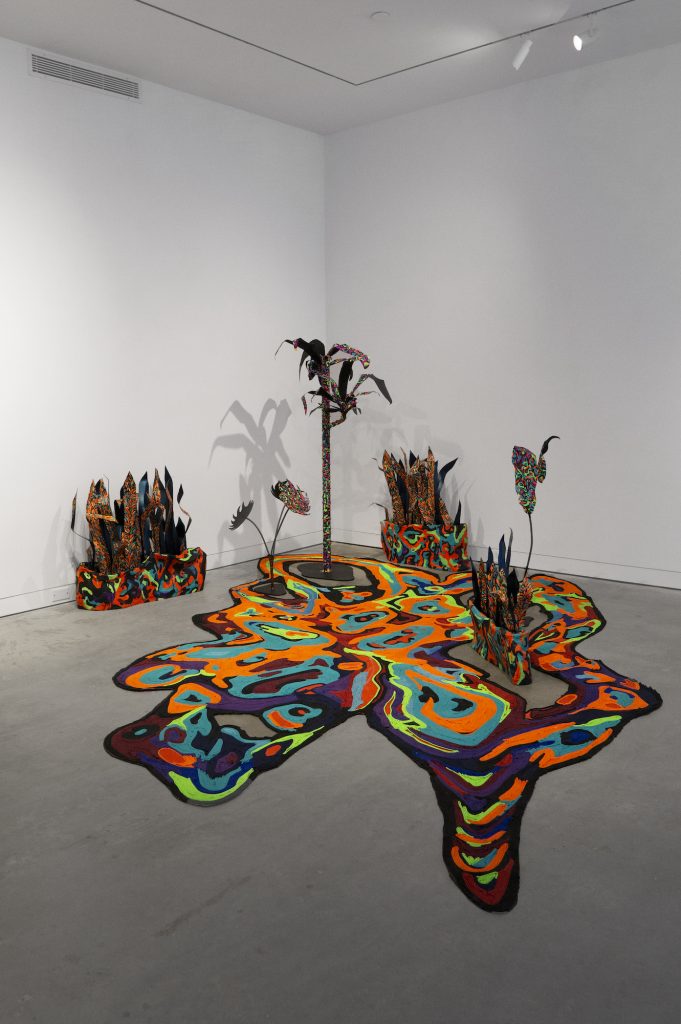
Installation view “Phaan Howng: I’ll Be Back” at Dinner Gallery, New York, 2022.
She emphasizes a yellow journalism aspect of the era that let these stories flourish. “The expeditions to other parts of the world that were bringing back these plants were very risky and expensive,” she said, “To help fund the journeys, these companies would put out fake news about man-eating trees in other parts of the world to drum up interest.”
These Victorian narratives coalesced in her mind with her enthusiasm of H.G. Wells and Kate Chopin. “I had this moment where I thought how funny it would be for plants to have their ‘awakening’ like the Kate Chopin novel,” she said. “I thought about ways plants might change themselves so that way they don’t get displaced by humans ever again.” These considerations led to new works investigating patterning and camouflage. These canvases evocatively straddle the real and unreal, with a hint of menacing latent potential.
“Before I started focusing on plants specifically, it was just like how Earth would defend itself after humans have all disappeared,” she explained. Now she says her works are tied to speculative futures, considering how plants may evolve. The possibilities keep growing. “One idea is that plants’ colors are going to be crazier, brighter, and more vivid because of all the crap we have put into the earth. I use neons in my works, but the idea is that these hues have been transformed and adapted by plants,” she said. “The plants are thriving.”
As for the works she’s developing for the fall, Howng is aiming for an “IMAX experience” in which viewers are fully enthralled and enveloped by the visuals of botanical life. She has no plans to deviate from her pop-Victorian plant subject matter anytime soon. “This is a rabbit hole that will last me another million years,” she said.
More Trending Stories:
A British Couple Actually Paid Nearly $250,000 to Remove a Banksy Mural From Their Building Due to the ‘Extremely Stressful’ Upkeep
Archaeologists in Hungary Have Uncovered the Remains of an Ancient Roman Doctor Alongside His Surgical Toolkit
The World’s First A.I.-Generated Statue, Cobbling Together the Styles of Five Celebrated Sculptors, Has Landed in a Swedish Museum
Meet the Young Collectors Calling the Shots at the Guggenheim, a Highly Placed Art Worlder’s Anti-Woke Tweets, and More Art World Gossip
An Extraordinary Wristwatch Belonging to the Last Emperor of China Just Sold for $6.2 Million, Setting Multiple Auction Records
A Sculpture Depicting King Tut as a Black Man Is Sparking International Outrage
Archaeologists Have Found a 3,000-Year-Old Bakery in Armenia, After Realizing a Layer of Ash Was Actually Wheat Flour
Why the Supreme Court’s Decision in the Andy Warhol Copyright Case Shows the Dangers of a Sympathy Vote
An Exhibition of Taylor Swift’s Stuff Has Just Opened at the Museum of Arts and Design. Here Are 5 Must-See Displays, Swifties






